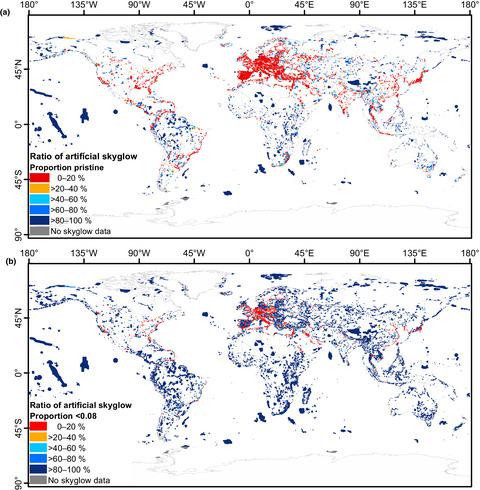当前位置:
X-MOL 学术
›
Anim. Conserv.
›
论文详情
Our official English website, www.x-mol.net, welcomes your
feedback! (Note: you will need to create a separate account there.)
Skyglow extends into the world's Key Biodiversity Areas
Animal Conservation ( IF 2.8 ) Pub Date : 2019-02-10 , DOI: 10.1111/acv.12480 J. K. Garrett 1, 2 , P. F. Donald 3, 4 , K. J. Gaston 1, 5
Animal Conservation ( IF 2.8 ) Pub Date : 2019-02-10 , DOI: 10.1111/acv.12480 J. K. Garrett 1, 2 , P. F. Donald 3, 4 , K. J. Gaston 1, 5
Affiliation

|
The proportion of the Earth’s surface that experiences a naturally dark environment at night is rapidly declining with the introduction of artificial light. Biological impacts of this change have been documented from genes to ecosystems, and for a wide diversity of environments and organisms. The likely severity of these impacts depends heavily on the relationship between the distribution of artificial night-time lighting and biodiversity. Here, we carry out a global assessment of the overlap between areas of conservation priority and the most recent atlas of artificial skyglow. We show that of the world’s Key Biodiversity Areas (KBAs), less than a third have completely pristine night-time skies, about a half lie entirely under artificially bright skies and only about a fifth contain no area in which night-time skies are not polluted to the zenith. The extent of light pollution of KBAs varies by region, affecting the greatest proportion of KBAs in Europe and the Middle East. Statistical modelling revealed associations between light pollution within KBAs and associated levels of both gross domestic product and human population density. This suggests that these patterns will worsen with continued economic development and growth in the human population.
中文翻译:

Skyglow 延伸至世界主要生物多样性区域
随着人造光的引入,地球表面在夜间经历自然黑暗环境的比例正在迅速下降。从基因到生态系统,以及对环境和生物的广泛多样性,这种变化的生物影响已经被记录在案。这些影响可能的严重程度在很大程度上取决于人工夜间照明的分布与生物多样性之间的关系。在这里,我们对优先保护区域和最新的人造天光图集之间的重叠进行了全球评估。我们表明,在世界上的关键生物多样性区 (KBA) 中,只有不到三分之一的地区拥有完全原始的夜空,大约一半完全位于人造明亮的天空下,只有大约五分之一不包含没有夜空的区域污染到了极点。KBA的光污染程度因地区而异,欧洲和中东的KBA影响最大。统计模型揭示了 KBA 内的光污染与国内生产总值和人口密度的相关水平之间的关联。这表明这些模式将随着经济的持续发展和人口的增长而恶化。
更新日期:2019-02-10
中文翻译:

Skyglow 延伸至世界主要生物多样性区域
随着人造光的引入,地球表面在夜间经历自然黑暗环境的比例正在迅速下降。从基因到生态系统,以及对环境和生物的广泛多样性,这种变化的生物影响已经被记录在案。这些影响可能的严重程度在很大程度上取决于人工夜间照明的分布与生物多样性之间的关系。在这里,我们对优先保护区域和最新的人造天光图集之间的重叠进行了全球评估。我们表明,在世界上的关键生物多样性区 (KBA) 中,只有不到三分之一的地区拥有完全原始的夜空,大约一半完全位于人造明亮的天空下,只有大约五分之一不包含没有夜空的区域污染到了极点。KBA的光污染程度因地区而异,欧洲和中东的KBA影响最大。统计模型揭示了 KBA 内的光污染与国内生产总值和人口密度的相关水平之间的关联。这表明这些模式将随着经济的持续发展和人口的增长而恶化。











































 京公网安备 11010802027423号
京公网安备 11010802027423号